Quick Film Project 1
GOAL / INTENTION:
GOAL: The goal of this film is to get evidence of cinematography for my peers.
INTENTION: The intention of this film is to get some really cool shots and lighting.
SUMMARY
This is gonna be a hard and confusing sell to anyone wanting to come on the project. I’ll start by saying that the purpose of this is gathering evidence of cinematography, as I know Neil and Dexter need it. The initial idea was simply that we would make a film in almost complete darkness, to attain a greater degree of control over the light that is present. In essence, this film will follow two pairs of hands playing Jenga, in a completely dark room save for the light directly about the Jenga tower. It’s hard to convey without visuals what this would look like, but I have some inspirations to share.
The first would be this performance by the trio Mummenschanz for two reasons. The first is the minimalistic sound design, the second is the wordless personality conveyed through motion.
The second would be the closing scene of Whiplash, mainly for the use of light and framing of the hands you see throughout this sequence.
This will all be far easier to communicate once I can get some storyboards and a script out, but for now, I’ll include a small materials list.
EQUIPMENT
- Camera
- Two pairs of thin gloves
- Blackout shades
- A very harsh directional light
- Other miscellaneous lights
- Bounce
- Microphone
- Jenga set
Comparative Study Worksheet 2020-21
Summary
A guide to planning, researching and creating your DP Film Comparative Study
- Follow the directions for each step below
- Include for your work where it is required
Student Work
- To be placed after students create posts
Steps and Tasks
- Brainstorm possible films for the task. You must select TWO films from contrasting cultural contexts.
- Brainstorm and justify at least three different areas of FILM FOCUS for your two chosen films.
- Brainstorm and justify at least two different CULTURAL CONTEXTS for your two chosen films.
- Consolidate your ideas and develop at least three different RESEARCH QUESTION topics for your study.
- Finalize your choices and select your RESEARCH QUESTION. Choose two films for comparison.
- Develop the main arguments you will make about your topic.
- Collect evidence from the films that support your argument.
- Research secondary sources for information that supports your argument.
- Write your Narration and plan the audio-visual components of your video essay.
- Record, assemble, and edit your Comparative Study Video Essay.
- Create a Works Cited document (separately) once your Comparative Study is finished.
Guidance for Your Work
“Simple formative analysis of film elements, no matter how precise or insightful, won’t cut it which is why the research question needs to be crafted in such a way that it provides scope for theoretical and socio-historic exploration. It’s basically an EE in disguise but focusing on two very different textual sources.”
- Thoroughly read the Comparative Study requirements in IB Film Guide PDF (including rubrics)
- Examine the CS Poster 1 (PDF)
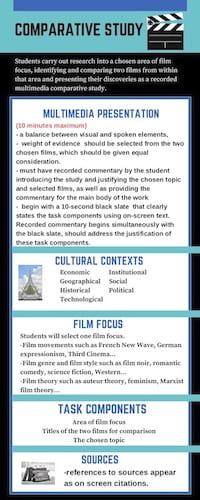
- Examine the CS Poster 2 (PDF)

- Watch Garrett’s CS Example and Read Garrett’s Two Column Script
- Notice the color designating justified film language elements
- Watch another example about South Korean New Wave
Comparative Study Task Components
For this assessment task, each student identifies, selects, and researches each of the following task components.
- TASK 1: One area of film focus.
- TASK 2: Two films for comparison from within the chosen area of film focus, one of which originates from a contrasting time (historical) or space (geographical) to the personal context of the student, and the other film identified for comparison must arise from a contrasting cultural context to the first film. Students are required to select films they have not previously studied in depth. The selected films cannot come from the prescribed list of film texts provided for the textual analysis assessment task and, once selected, the films cannot be used by the student in any other assessment task for the DP film course or the extended essay.
- TASK 3: A clearly defined topic for a recorded multimedia comparative study, which links both the selected films and the identified area of film focus. Each student should invest time in researching, developing, and honing their topic (which in most cases is likely to be expressed in the form of a research question) to ensure it is clear, focused and concise, in order to provide them with the maximum potential for success in this task. The topic should seek to enrich the student’s understanding of the chosen area of film focus and should avoid a plot-driven approach to the comparison.
The assessment criteria for this task requires students to provide a strong justification for the choice of task components as part of the recorded multimedia comparative study. This includes the student’s justification for how films arise from contrasting cultural contexts.
1. FILM Choices List
| Which films are you considering for your final Comparative Study? List as many as you wish below as part of an initial brainstorm. Remember that you must select TWO films from contrasting cultural contexts for this task.e.g. CITIZEN KANE | Year, Country, and Director of the film.e.g. 1941, USA, Dir: Orson Welles |
| The Birds | 1963, USA, Dir: Alfred Hitchcock, Rick Rosenthal |
| Scream | 1996, USA, Dir: Wes Craven, Tyler Gillet, Matt Bettinelli-Olpin |
| Hereditary | 2018, USA, Dir: Ari Aster |
2. Areas of FILM FOCUS
- Research Film Movements
- Research Film Genres
- Research Film Style (difference between genre and film style defined)
- Research Film Theory
| Film Focus Possibility – identify the broad focus area and then add specifics (e.g. “THEORY – Auteur theory” or “GENRE – Horror”). Develop at least THREE options…you can create more by adding more rows. | Justification for this Film Focus. Be as specific as possible. |
| Horror genre | All three are horror movies |
| Originality | The horror genre seems to demand originality more so than other genres. |
| Freudian Theory | I want to see how each film approaches the “Death drive”. |
3. Chosen CULTURAL CONTEXT
For this assessment task, “cultural context” involves consideration of some of the following factors, some of which may be blended (such as socioeconomic factors).
- Economic, Geographical, Historical, Institutional, Political, Social, Technological
| Identify at least TWO Cultural Context possibilities for your chosen films. |
Justification for this Cultural Context. Be as specific as possible. |
| Social | The main fears of the times change, and tropes are acknowledged and worked around. |
| Technological | The film techniques used to generate fear evolve over time as the old methods either prove themselves or get worn out. |
4. RESEARCH QUESTION Possibilities
Consolidate your thoughts above and develop at least THREE different research question possibilities. More are possible by adding additional rows to the table below. FYI these will be shared with the full class for discussion of strengths and weaknesses.
| Your Chosen Area of Film Focus | Topic for Comparative Study (written as a research question) |
5. Final Decisions
Using your topic options in the table above, select ONE to be your final topic for this Comparative Study task. NOTE: There are examples from the IB of what this should look like below this table.
| Your Chosen Area of Film Focus | Film 1 | Film 2 | Contrasting Cultural Context | Topic for Comparative Study practice task (written as a research question) |
| Originality |
6. Developing Your Topic
| Develop 3-5 main arguments that can be made about your topic based on your research question and chosen film focus. | Brainstorm how you could support these arguments within your video essay. |
7. Selecting Supporting Evidence (Primary)
| Identify at least 15 scenes from your chosen films that will help support the arguments you have outlined above. Screen clip a frame from each scene below. | Write notes about how this scene helps support your argument. (These notes will help form your voice-over narration.) |
*Add more rows as needed.
8. Selecting Supporting Evidence (Secondary)
| Identify at least 3-5 secondary sources (articles, books, websites, video essays, etc.) which provide information that help support your arguments being made. In this column include the specific source citations. | Summarize the detailed information from the secondary source that you can use in this column. (You can copy+paste if they are from online sources.) |
*Add more rows as needed.
9. Writing Your Narration
Using the information, scene choices, and external sources you have compiled in parts 6-8, you will now write your voiceover narration and match it up to your chosen visual examples.
For the final Comparative Study, your narration should be no longer than 10 minutes in length.
Assemble in Two-Column AV Formatt in Celtx (Tutorial) or use Google Docs
Remember that you need to:
- COMPARE and CONTRAST your two chosen film using the arguments and evidence you identified in parts 6-8
- Begin your narration with a detailed justification for the chosen cultural contrast
- Use an equal balance of the two selected films.
- Write in a third-person voice to construct your argument (similar in tone to your Extended Essay and other
comparative analytical work you have written in Film class). - Identify where any WRITTEN TEXT will appear on the screen and highlight this (to reference during the
creation/editing stage)
| Voiceover Narration Ideas | Which visual evidence/scenes line up to this part of the narration? |
10. Assembling the Comparative Study
Now you will collect all media resources needed for the task and construct your video essay.
REQUIRED STEPS
- Import the digital copy of your chosen films into editing software
- Identify and extract chosen scenes and clips
- Place and edit clips into a rough timeline for your video essay
- Record audio narration (both partners should participate in narrating this practice task)
into an audio file using recording equipment (Zoom recorders, iPhone, DSLR Rode video
mic, etc.) - Import your recorded narration audio file into your project timeline
- Assemble, edit and fine-tune clips and narration until your video essay takes shape
- Create and add any required textual information in the timeline (including black slate at the start)
- Audio mixing of narration and movie clips (adjust levels so that narration and movie sounds complement each other)
- Export the final video essay movie file
- Upload Unlisted draft to YouTube for peer review
- Create Works Cited list separately (Google Doc)
*NOTE: Separate tutorial and tips sessions will be held throughout this process to provide guidance on recording your voice-over narration and mixing the audio levels successfully.
Examples of Possible Task Components (from the IB)
| Area of film focus | Film 1 | Film 2 | Possible topic for comparative study |
| Film movement: German Expressionism | The Cabinet of Dr. Caligari (1920) | Edward Scissorhands (1990) | How and with what effect are specific film elements of German expressionism used within a chosen contemporary film? |
| Film movement: French New Wave | Breathless (1960) | Badlands (1973) | The influence of the French New Wave on New Hollywood’s use of innovative film elements in its representation of youth and violence. |
| Film genre and film style: Black comedy | No. 3 (1997) | The Big Lebowski (1998) | To what extent do “black comedy” films differ according to cultural context? |
| Film theory: Soviet Montage | Battleship Potemkin (1925) | Koyaanisqatsi (1982) | To what extent are specific features of Soviet montage theory faithfully employed in a contemporary experimental film? |
External Assessment Criteria SL and HL
Peer Review Checklist
| TASK COMPONENTS (ACTION) | Notes / Suggestions | |
| __ | Assemble Findings | |
| __ | Develop a personal and critically reflective perspective | |
| __ | Identify and gather appropriate audio-visual material to support the study | |
| SCREENPLAY | ||
| __ | Justify the chosen topic and selected films | |
| __ | Make sure that the text is in a formal academic register (can be in the 1st person) | |
| __ | Balance between visual and spoken elements | |
| __ | Make clear reference to your sources as on-screen citations (text on-screen) | |
| __ | Make sure primary weight of evidence for the study from the two chosen films | |
| __ | Make sure each film is given equal consideration | |
| __ | Make sure film language information is communicated clearly throughout (avoid “to be” verbs – make statements like “blah is this.”) | |
| __ | Make sure information is communicated logically rooted in film language | |
| __ | Have another student highlight the WHAT WHY HOW in your draft screenplay | |
| VIDEO ESSAY | ||
| __ | Recorded voice and edited commentary numerous times until happy with the material | |
| __ | Make sure your name and the school’s name ARE NOT IN THE ESSAY | |
| __ | Make sure to have 10 second title card with: 1. Area of film focus, 2. Titles of the two films for comparison, and 3. The chosen topic | |
| __ | Include breaks in your recorded commentary to enable other audio-visual material included in the study to be clearly heard (if needed) | |
| __ | Make sure film clip length matches points being made | |
| __ | Make sure still images have citations on-screen, if you have them | |
| __ | Make sure text on screen is legible and spelled correctly | |
| __ | Make sure information is communicated audibly (levels are good for all sound) | |
| __ | Make sure information is communicated visually appropriate manner | |
| __ | Make sure background music is from Creative Commons and is cited | |
| __ | Make sure edits are clean | |
| __ | Make sure presentation is 10 minutes maximum, including title card and credits | |
| __ | Make sure two films are listed in sources | |
Film – Week 10 – GTD – Getting Things Done – Part 2
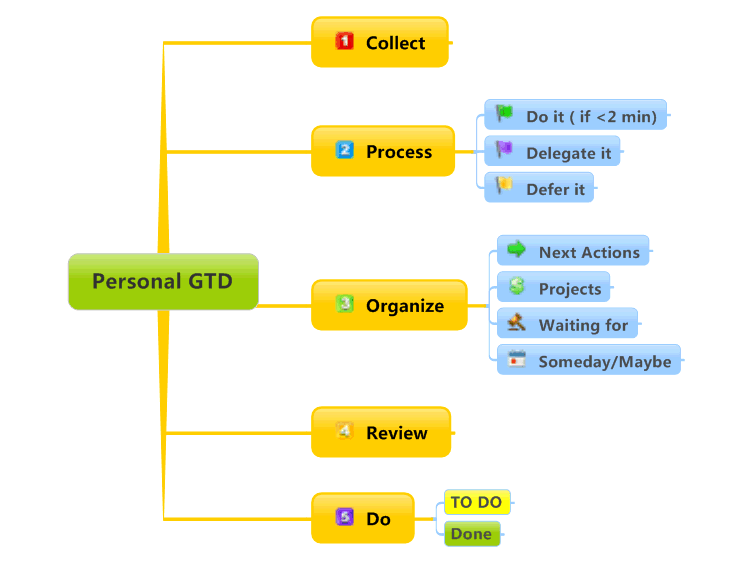
Teens are overwhelmed, partly because they don’t yet have the skills to manage the unprecedented amount of stuff that enters their brains each day. – from LifeHacker.com
“Your mind is for having ideas, not holding them.”
“You can do anything, but not everything.”
― David Allen, (GTD) Getting Things Done for Teens: Take Control of Your Life in a Distracting World
SUMMARY
- This week, I completed a TOK assignment, an art assignment, an English assignment, and a film assignment. I am hoping to do more film by the end of today, and I have been working on a math project with my friend, due next Wednesday.
PRACTICE ROOM (TUTORIALS)
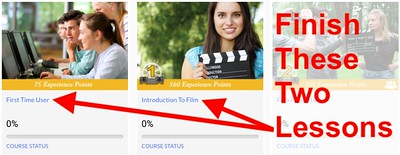
CLASSROOM (THEORY & ANALYSIS)

You are going to learn to develop your own version of David Allen’s Getting Things Done (GTD) process in this ‘room.’
- The idea of organizing a space to make it a mess really clicked with me. Looking back, there were many times where the buildup of things has left me petrified to approach any of them. The other part that really stuck with me is when referring to writing your thoughts down, Allen said “Don’t have a thought twice.” When I get stressed out certain thoughts tend to keep bouncing back and forth in my head. I’m not talking about self-doubt, but when creating a plan for what I’ll do, I will revisit it a couple hundred times in my head instead of writing it down. I do the same with distracting thoughts and social situations, revisit and dissect them until I’m exhausted by the idea. I imagine I could make a lot more time for myself, looking at it this way.


Examine Two GTD Maps: Basic and Detailed
- Detailed map by guccio@文房具社 icensed under CC BY-NC 2.0
- Basic map from BiggerPlate.com embedded below
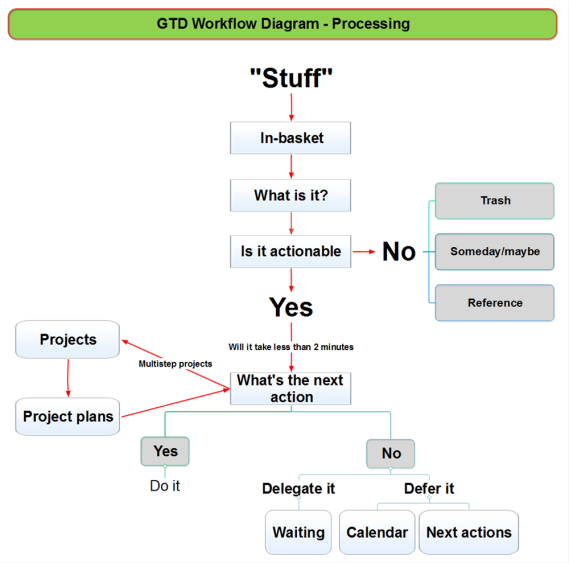
GTD-based Trusted System

OUTSIDE (PRODUCTIVITY & THE BRAIN)
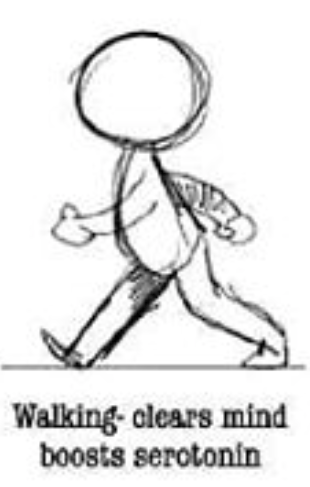
OPTIONAL EXERCISE

- Read Getting Things Done for Teens: Take Control of Your Life in a Distracting World by David Allen
WHAT I LEARNED and PROBLEMS I SOLVED
- I learned that ‘time-saving’ is the wrong word since time is never the issue. The organization, not only of time but of our surroundings, is what contributes to the space to breathe we can achieve.
- I was struggling to get anything done and assignments, like this one, went unfinished. I used the system I made and have been working slowly through all of them, with my pace getting faster as I go.
Film – Week 10 – GTD – Getting Things Done – Part 2

Teens are overwhelmed, partly because they don’t yet have the skills to manage the unprecedented amount of stuff that enters their brains each day. – from LifeHacker.com
“Your mind is for having ideas, not holding them.”
“You can do anything, but not everything.”
― David Allen, (GTD) Getting Things Done for Teens: Take Control of Your Life in a Distracting World
SUMMARY
- Write your weekly summary here, last, at the end of the week…
- Only one to two sentences of WHAT YOU DID
PRACTICE ROOM (TUTORIALS)

- Set a timer
- Spend up to 60 minutes in this ‘room’
- Learn how to Access and Complete Curriculum at Sneakonthelot.com
- 1 minute Le Duc Video Tutorial
- Complete…
- First Time User
- Introduction To Film
CLASSROOM (THEORY & ANALYSIS)

You are going to learn to develop your own version of David Allen’s Getting Things Done (GTD) process in this ‘room.’
- Set a timer
- Spend 45 minutes in this ‘room’
- Spend 20 minutes watching The Art of Stress-Free Productivity: David Allen
- Spend 10 minutes watching Getting Things Done (GTD) by David Allen – Animated Book Summary And Review
- Spend 5 minutes reading Help Teens De-Stress With These ‘Getting Things Done’ Hacks
- Spend 10 minutes writing a small paragraph reflection
- DELETE ALL OF MR. LE DUC’s INSTRUCTIONS, AFTER YOU ARE DONE
LAB (THEORY PRACTICED)

- Set a timer
- Spend 15 minutes in this ‘room’
- Rewatch David explain ‘Maps’ from 19:57 to 21:16 of the video

Examine Two GTD Maps: Basic and Detailed
- Detailed map by guccio@文房具社 icensed under CC BY-NC 2.0
- Basic map from BiggerPlate.com embedded below

GTD-based Trusted System

- Examine and pick a trusted system from the 4 options listed below to ‘capture’ your work
- A trusted system is your method for managing your tasks in a way that you consistently get things done
-
- Trello.com with a – GTD Template
- We use Trello in this class to manage group projects
- You will create a Trello account a few weeks from now regardless
- You might want to start now
- We start using Trello in the second semester
- Watch Mr. Le Duc Creating a Trello Account and Add GTD Template Tutorial (3:45)

- You can get the free Trello app at the Apple Store or Google Play

- We use Trello in this class to manage group projects
- Your phone
- Paper and pen or pencil
- Examine LifeHacker.com’s GTD Resources
- Trello.com with a – GTD Template
OUTSIDE (PRODUCTIVITY & THE BRAIN)

- Go for a 15-minute walk, if it is safe to do so and follow the advice from David Allen
- Bring a notepad
- Walk and relax and allow your mind to wander
- If you land on something that needs your attention, write it down
- Continue throughout your walk
- DELETE ALL OF MR. LE DUC’s INSTRUCTIONS, AFTER YOU ARE DONE
OPTIONAL EXERCISE

- Read Getting Things Done for Teens: Take Control of Your Life in a Distracting World by David Allen
STUDIO (CREATING MAPS)
- Set a timer
- Spend up to 15 minutes
- Then watch David Allen summarize the steps
- “Very simple folks! …
- Just WRITE STUFF DOWN
- Decide the ACTIONS and OUTCOMES embedded in them
- Get yourself a MAP OF ALL THAT so you can step back and take a look at it.
- And then, basically, you USE THE MAP TO DECIDE, “OK, here’s the course that we’re going to go on.”
- You then LAUNCH the ‘ship’ on a trusted course in the short term, as well as on the long horizon that you’re moving on.
- And then, on a regular basis, you need to REASSESS, “OK, we need to take in NEW DATA, CLEANUP, RECALIBRATE, and REFOCUS for the next leg of the journey.”
- It’s that simple…”
- “Very simple folks! …
- ‘Capture’ all the ACTION ITEMS you can in your GTD Trusted System
CONTROL ROOM (PRODUCTION)
- Set a timer
- Spend 10 minutes in this ‘room’
- Share your system with the class in the Schoology Week 10 Discussion Board
- Take a picture or screenshot and post on our Schoology page
- Prepare to briefly share how your system helps you…
- Capture Action Items
- Process them
- and Organize them
- DELETE THIS WHOLE SECTION, AFTER YOU ARE DONE
WHAT I LEARNED and PROBLEMS I SOLVED
- Write only a few sentences of WHAT YOU LEARNED
- In one or two sentences, describe a PROBLEM YOU SOLVED
- DELETE ALL OF MR. LE DUC’s INSTRUCTIONS, AFTER YOU ARE DONE
WEEKLY ACTIVITY EVALUATION
- Give feedback on this week’s class Content and Process
- Fill in the Weekly Activity Evaluation
- DELETE THIS WHOLE SECTION, AFTER YOU ARE DONE
Week 9 – GTD – Getting Things Done – Part 1

“Day 092/366 – To Do List” by Great Beyond is licensed under CC BY-NC-SA 2.0
Your toughest work is defining what your work is! – Peter Drucker
SUMMARY
- I completed my University of Washington application and two art assignments, a math assignment, two english assignments, and a ceramics assignment.
CLASSROOM (THEORY & ANALYSIS)
PRACTICE ROOM (TUTORIALS)
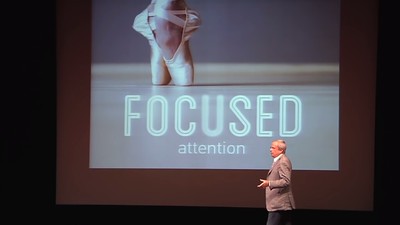
In this ‘room’ you are going to try Getting Things Done (GTD).
STEP 1: MAKE A LIST
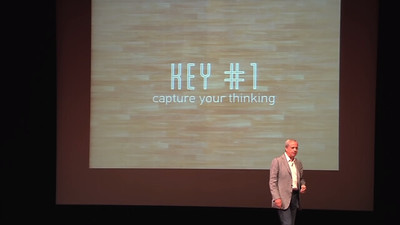
- Set a timer
- Spend up to 5 minutes
- Finish sketch of arm for Ceramics
- Do English essay about self
- Finish WSU application
- Do today’s math homework
- Do first Sneakonthelot assignments
STEP 2: NOTICE WHAT YOU NOTICED
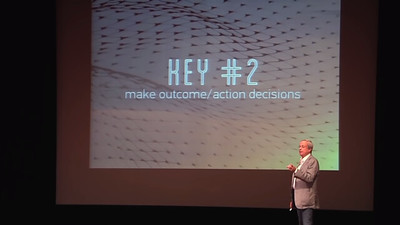
- Set a timer
- Spend up to 5 minutes
- Prioritize your list, here in this section of your blog
- Finish WSU Application
- Do first Sneakonthelot assignments
- Do English essay about self
- Do today’s math homework
- Finish sketch of arm for Ceramics
- DELETE ALL OF MR. LE DUC’s INSTRUCTIONS, AFTER YOU ARE DONE
STEP 3: SET A TIMER

- Set a timer for your first task
- Decide how long you think it will take before you start
- Start working
- Repeat this process for 45 minutes for as many tasks as you can complete, then take a 15-minute break
- Get up and get a drink of water
- Get up and go for a walk
- Every 20 minute blink your eyes 20 times while looking at least 20 feet away
- This is good for your eyes
Start steps 1 through 3 again, repeat for your school day
OUTSIDE (PRODUCTIVITY & THE BRAIN)
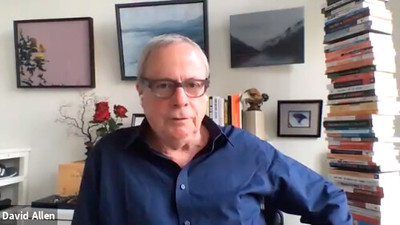
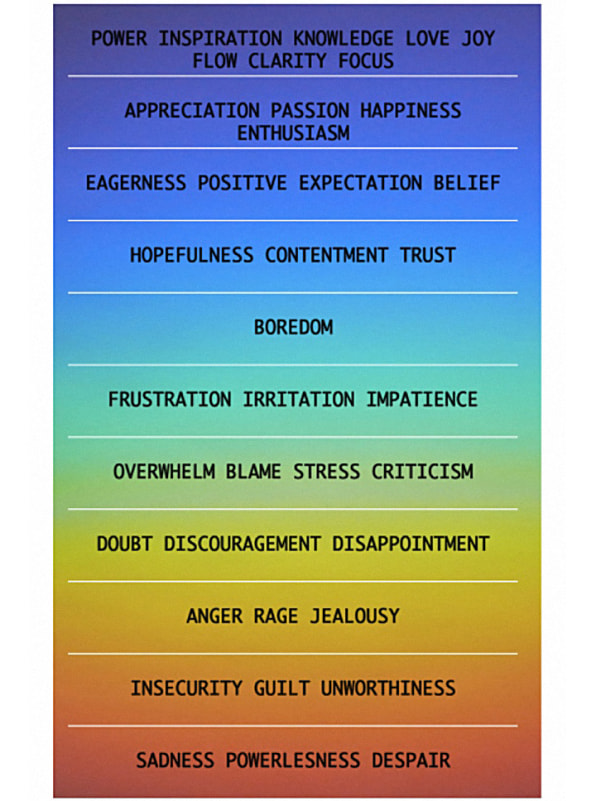
- The goal is getting my GTD to the point it becomes self-sustaining if that makes sense. Obviously, no one wants the low end of the list, but it’s a wheel that can spin in both directions. It would be best to have a plan to stop the wheel once it starts spinning negative.

- The rain was cruel today, but the discomfort of the elements was far easier to brave than the stress of sitting motionless in front of my computer, knowing what I should be doing and yet not doing it. That first step is vital, the time when you realize the confusion of where to start that was causing you so much stress was only a puddle deep. I’d better finish this up as well as the second GTD assignment.
WHAT I LEARNED and PROBLEMS I SOLVED
- I learned that any system which allows you to push back your responsibilities to uncertain times is a faulty one.
- This and a few other assignments have been woefully late as my focus has shifted to college applications, but now I am working my way through them all. I feel less stressed than I have been in a long while.
Developing Quality Workflow
What is Workflow?

Work•flow /ˈwərkflō/
“The sequence of industrial, administrative, or other processes through which a piece of work passes from initiation to completion.” – lexico.com
What is a quality workflow? How do we develop it? Below are elements of the production cycle that most creative people move through as they create something. First, we must identify the stages of project production. What is each stage and what are the quality checks for each stage. Read on and find out!
Stages of Creation Development
Inspiration
How do we find ideas to develop?
- WHAT TOOLS SHOULD WE USE?
- You can pull from your own experience, utilizing memory as a tool.
- You can observe media to try and pick up on common themes you might try to build upon.
- WHAT PROCESS SHOULD WE USE?
- A brainstorming chart, collage, or any other way to compile and organize components of your idea.
- HOW DO YOU MEASURE QUALITY?
- Depth itself is not an apt way to judge the quality of an idea, the solidity of what you will do with it is far better. It is not so much about having a place to start, as it is having a place to end, in which the meat of the center may be built upon.
- WHO MEASURES QUALITY?
- In the idea department, you should be the one who has judgement on whether or not it is good, unless someone is asking you for your idea, in which case it’s them who measures quality.
Intention
How do we clarify our specific goal(s) for a project?
- WHAT TOOLS SHOULD WE USE?
- Other people working on the project, wise friends, and your own inspirations are good tools for intention.
- WHAT PROCESS SHOULD WE USE?
- Ask yourself the intention behind your idea which started the process.
- HOW DO YOU MEASURE QUALITY?
- It depends upon the intention, maybe it’s an emotion or message, in which case the audience’s retention of the ideas is how you can measure it.
- WHO MEASURES QUALITY?
- Your audience will determine the quality, since they can tell you if your intention came through.
Pre-production
How can we brainwrite, brainstorm, storyboard, and plan our ideas at this phase?
- WHAT TOOLS SHOULD WE USE?
- Your other team members, Trello, computers and paper.
- WHAT PROCESS SHOULD WE USE?
- Trello and text to work out a rough schedule with your team mates.
- HOW DO YOU MEASURE QUALITY?
- Being able to check off everything you wanted to accomplish in planning.
- WHO MEASURES QUALITY?
- You and your team.
Production
How do we communicate with each other and execute our plan for this phase? This is where we actually make the project.
- WHAT TOOLS SHOULD WE USE?
- Necessary equipment, logging sheets, communication tools.
- WHAT PROCESS SHOULD WE USE?
- Meet up with everyone you are working with, check equipment, then use it to do what you need to, and finally log what you did.
- HOW DO YOU MEASURE QUALITY?
- Your ability to pave the way for post-production, and leave no work to do beforehand in a timely fashion.
- WHO MEASURES QUALITY?
- Those who work on post-production will measure your quality, and you will too.
Post-production
How do we communicate with each other and execute our final stages of the project for this phase? This is where we publish the project.
- WHAT TOOLS SHOULD WE USE?
- Editing software, your team’s wisdom and the project director.
- WHAT PROCESS SHOULD WE USE?
- Use the logs to organize your content, then sculpt it into the intentions set in pre production and before that.
- HOW DO YOU MEASURE QUALITY?
- The refinement of the final product compared to it’s state in production.
- WHO MEASURES QUALITY?
- Your intended audience.
Presentation/Performance
How do we share our project with our learning community, advisory members, and the world?
- WHAT TOOLS SHOULD WE USE?
- Festivals, galleries, online forums and spaces in which it can be published.
- WHAT PROCESS SHOULD WE USE?
- Prepare to present your creation, know what you are going to say.
- HOW DO YOU MEASURE QUALITY?
- The reaction of the audience.
- WHO MEASURES QUALITY?
- The audience you present your work to.
Feedback
How do we conduct a feedback session at the end of the project development cycle?
- WHAT TOOLS SHOULD WE USE?
- Recording device to record feedback, be it digital or pencil and paper. Also, a little humble pie.
- WHAT PROCESS SHOULD WE USE?
- Be patient, consider each opinion which reviews you
- HOW DO YOU MEASURE QUALITY?
- You can measure it by the composition of the feedback. For example, feedback that explicitly references parts of the project is more valuable than a blanket statement.
- WHO MEASURES QUALITY?
- The quality of feedback is measured by you and anyone else working on the project.
Recipe For Success: Calvin Werts
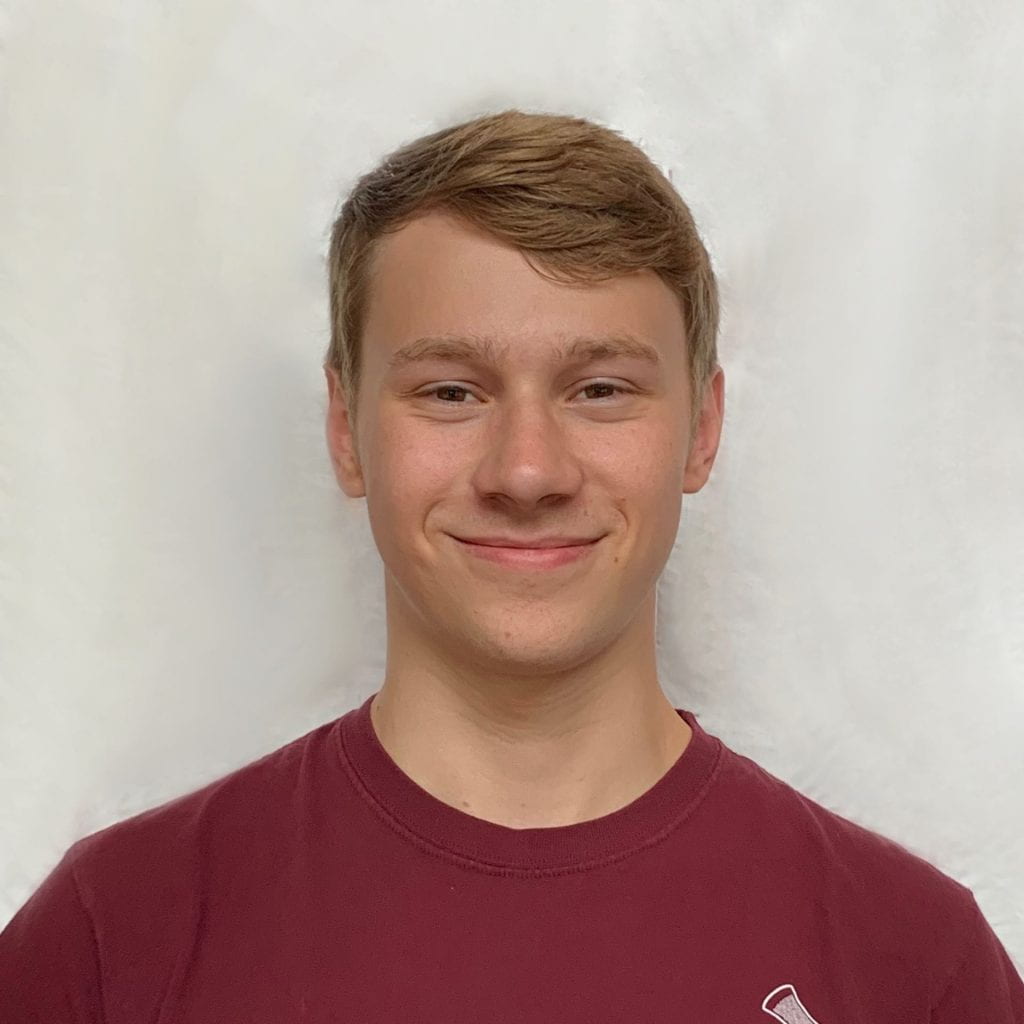
Born September 22nd in Olympia, Washington
Personal Success Definition
I define success as having the courage and skill to do what you are passionate about with your life, while also being successful in your own terms. To have that success propelled by your own ambition and drive is what makes it real to me.
Calvin Werts is above the curve for where he is. He is swimming in college, a goal he had sought after through high school, and has gotten a job filming and editing in the swimming community, which is exactly the job he wanted to have. He earned every part of it, taking the opportunities where they came despite anything difficult happening in his life at the time.
Skills for Success
Calvin Werts is a dedicated worker, a risk taker and someone who loves to laugh. When he sets his mind to something, it will get done. He goes for the result he wants consistently, not necessarily what would be conventional. With all that being said, he is never overly serious, and wants to have fun in his work when he can.
How They Used These Skills
Calvin used his connections in the swimming world he had accumulated through his hard work to get his foot in the door of his favorite work field under that subject matter. He had done volunteer work for the titular CG of CG Sports in order to secure the job he has now. That was a payback 2 years in the making.
Challenges Overcome
Calvin Werts spends most of his time spinning multiple plates, and he finds the time and energy to put into each of them. Through high school he swam 5 hours a day, while also doing full IB and other extracurricular activities Now in college, he has a job as the video editor of a athlete management company alongside his regular classes.
Significant Work
Calvin can let his talent for creative editing and cinematography shine in his current occupation.
Resources
Me
https://www.youtube.com/channel/UCDl4va6clqw_4dgzoh-P-uw – CG Sports Company
Dylan Werts
What Is My Why?
My why is defined by how what I am doing impacts the people I care about, my own happiness, and what others think of me.
Myers-Briggs Personality Quiz
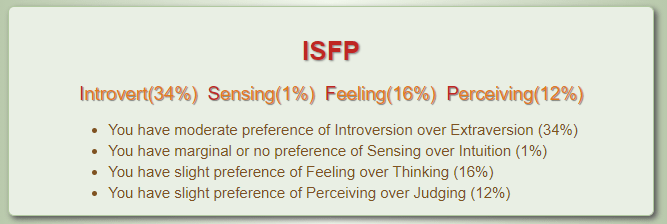
Multiple Intelligence Quiz

Shape Theory
Top shape: Circle
Second shape: Triangle
Third shape: Zigzag
Career Pathway
I would want to be either a storyboard maker or concept artist.

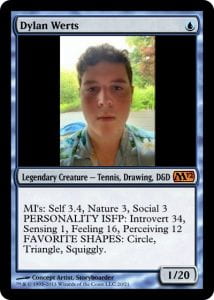
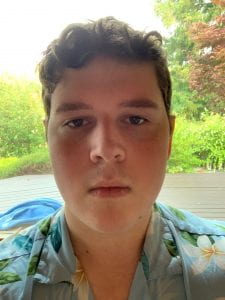 (This is the photo, I added the black bars so that it would fit.)
(This is the photo, I added the black bars so that it would fit.)
Story of Film Episode 15
2000 Onwards: Film Moves Full Circle – and the Future of Movies.
- Swiss Miss (1938) dir. John G. Blystone and Hal Roach
- I love Laurel and Hardy! My grandpa used to show them all to me.
- Very inventive with catastrophe.
- Blonde Venus (1932) dir. Josef von Sternberg
- Like Swiss Miss, there is a gorilla.
- Hollywood being strange and playful.
- Employees Leaving the Lumiere Factory (1895) (introduced in Episode 1) dir. Louis Lumière
- Fahrenheit 9/11 (2004) dir. Michael Moore
- Reality became bigger than fiction.
- One of the most successful documentaries.
- The Bourne Supremacy (2004) dir. Paul Greengrass
- Made as much as Fahrenheit 9/11.
- Fiction, but filmed in a more documentary style.
- Être et avoir (2002) dir. Nicolas Philibert
- Shows great sadness in the retiring teacher.
- Zidane – A Portrait in the 21st Century (2006) dir. Douglas Gordon and Philippe Parreno
- Takes the viewer in the mind of one of the players.
- The Assassination of Jesse James by the Coward Robert Ford (2007) dir. Andrew Dominik
- Shallow, sepia footage, with de-focused edges.
- Way Down East (1920) (introduced in Episode 1) dir. D. W. Griffith
- Very soft lighting.
- Climates (2006) dir. Nuri Bilge Ceylan
- Carefully chosen planes of focus.
- The Death of Mr. Lazarescu (2005) dir. Cristi Puiu
- Follows a man, going from full hospital to full hospital, and slowly dying.
- Very realist.
- The Headless Woman (2008) dir. Lucrecia Martel
- Static camera gives a secretive tone.
- Framing makes her literally headless.
- Battle in Heaven (2005) dir. Carlos Reygadas
- Oasis (2002) dir. Lee Chang-Dong
- Very dark story line.
- Memories of Murder (2003) dir. Bong Joon-ho
- Flat planes of yellow, made from the grass of the fields.
- Breakthrough at the end is sadly underwhelming for the detective.
- Oldboy (2003) dir. Park Chan-wook
- Very interesting cross-section fight scene. Camera stays on a dolly for the whole fight.
- Le Voyage dans la lune (1902) (introduced in Episode 1) dir. Georges Méliès (Although Mark Cousins and the title on the screen indicate that the scene being shown is from La lune à un mètre, the scene is actually from Le Voyage dans la lune.
- Dreamlike and surreal content.
- Mulholland Dr. (2001) dir. David Lynch
- Filmed like a daydream in some sections.
- Strange audio mixing.
- Requiem for a Dream (2000) dir. Darren Aronofsky
- Gives a strange and realistic portrayal of drug usage.
- The film feels paranoid.
- Songs from the Second Floor (2000) dir. Roy Andersson
- Drab green color contrasts with sudden and grand score.
- Themes of guilt.
- Inspired by Laurel and Hardy.
- Way Out West (1937) dir. James W. Horne
- Indiscreet (1958) (introduced in Episode 5) dir. Stanley Donen
- Rules of Attraction (2002) dir. Roger Avary
- Similar split screen to Indiscreet.
- Cameras pull back to match, and the frame is made whole.
- Avatar (2009) dir. James Cameron
- All the CGI was tempered with motion captured faces.
- Motion Capture Mirrors Emotion (2009) dir. Jorge Ribas
- Shows how the CGI was done for Avatar.
- Tropical Malady (2004) dir. Apichatpong Weerasethakul
- Filmed naturally, as a hazy summer day.
- Switches to the intense life of the soldier very suddenly.
- Mother and Son (1997) dir. Alexander Sokurov
- Filmed very peacefully at the moment of a mother’s death.
- Beautiful imagery.
- Russian Ark (2002) dir. Alexander Sokurov
- Slowly moving camera shows all who are about to be killed in the uprising.
- Whole movie was filmed in a single take.
- In One Breath: Alexander Sokurov’s Russian Ark (2003) dir. Knut Elstermann
- Handheld camera shows the relief of the end of the movie being filmed.
Epilogue the Year 2046
- Inception (2010) (introduced in Episode 4) dir. Christopher Nolan
- Music is very atmospheric.
- Within each dream, the style of the film changes, for color, camera and sound.
- Eternal Sunshine of the Spotless Mind (2004) dir. Michel Gondry
- Very jumpy soundtrack, and filmed like a crime drama.